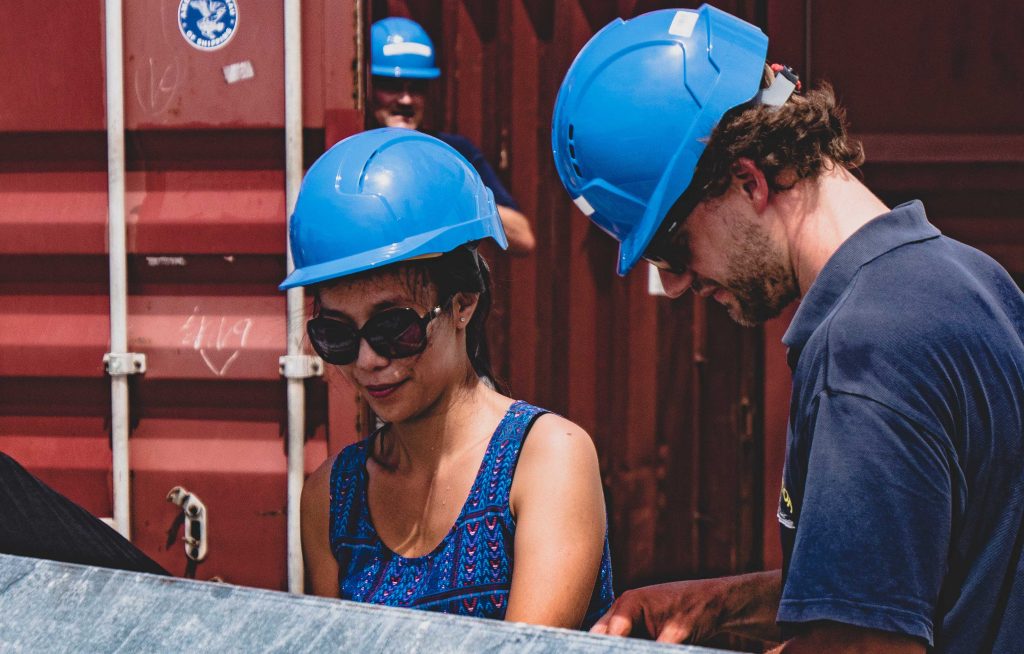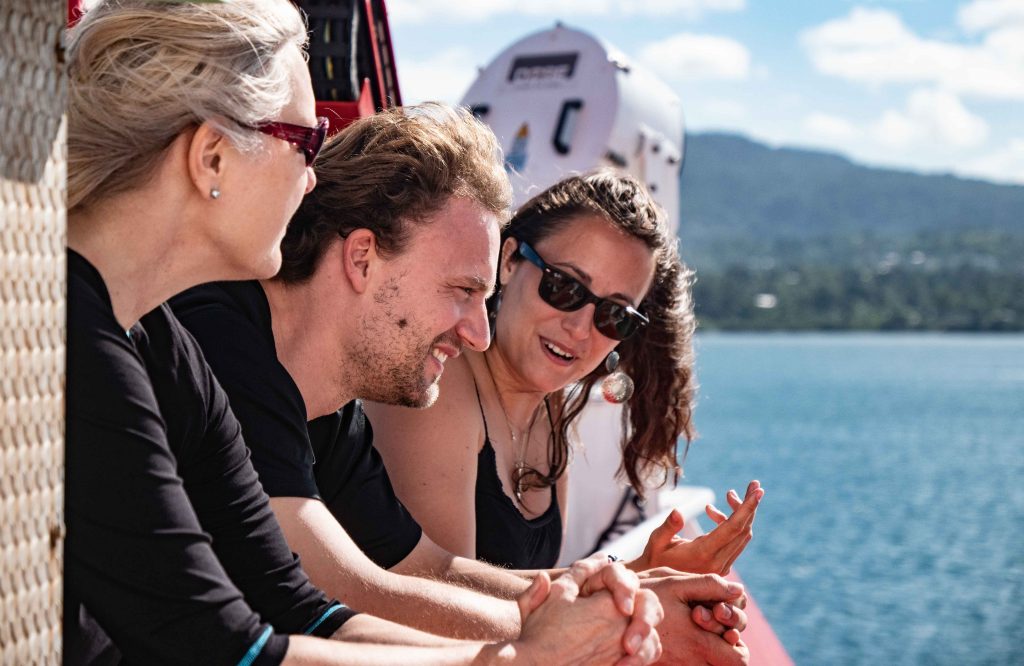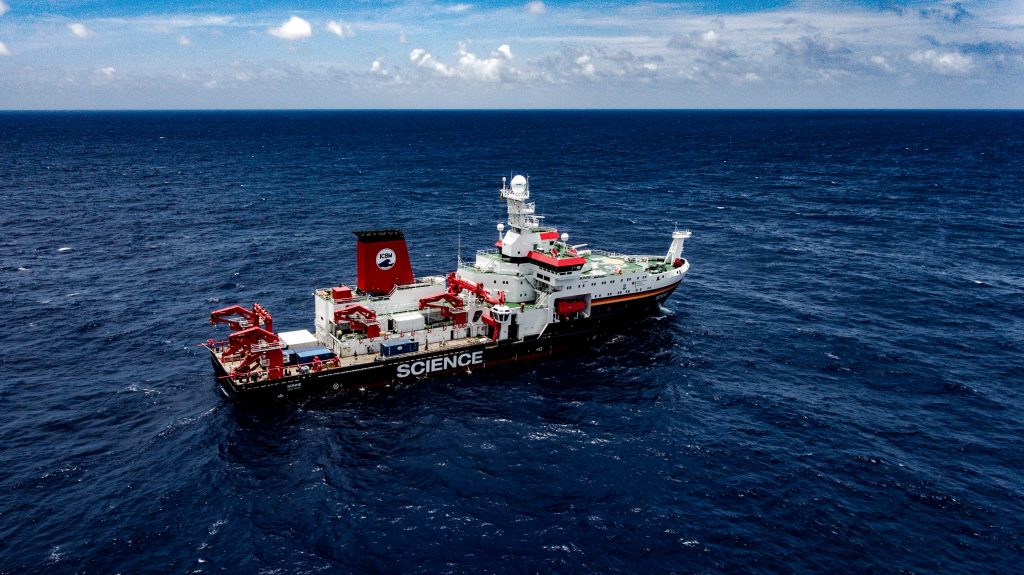Raising our gaze from the working deck over the rails of the ship, we see the sapphire blue sea overspread with small white caps that border the clear blue sky. A warm tropical breeze hangs in the air and it finally occurs to us that, yes, we are in the middle of the Pacific Ocean!
Who are we? Why are we here? Well, we are two PhD students from GEOMAR and Alfred-Wegner Institute (AWI), who have never met before but now have to share not only a 2-bed cabin onboard the RV SONNE but also the work and experiences related to our cooperating PhD projects for the next 3 years. We are here to collect data and samples from the Emperor Seamount Chain in the North Pacific for paleoceanographic and paleoclimatic studies.

Preparation of the coreing devices. Photo: Steffen Niemann
After a few days at sea, we have finally adapted to the heavy swell. Free of seasickness, over the rest of the week we could focus on unpacking the expedition boxes and setting up the laboratories. So far the most challenging part for us was to set up the giant coring device, called the Kasten Corer, which is made up of four 5.75m long segments. Under the tropical sun, we put together the bulky metal frames of this coring device. The tricky part was to match the wobbly edges perfectly so that we could screw them tight. Each segment was so heavy that at least four strong guys were needed to carry it. These segments were then piled up and secured on deck so they couldn’t be shifted around by the next big wave that hits the ship. While working on deck, we are always required to wear helmets and working shoes, which at times may feel rather uncomfortable in the hot weather, but ensures our safety. Overall, setting up for coring was heavy work with lots of sweat, but was also a great opportunity to test our ability to work as a team.
Beyond science, the life on RV SONNE has many faces. When the weather is nice most of the scientists spend their free time on the sun deck. We chat and laugh about everything — science, ideas, the next upcoming meal, our hobbies, our thoughts and also our cultural backgrounds. Therefore, we are having a great time getting to know each other and building new friendships. The gym is also a good place to meet people, but maybe a bit exhausting when the waves are too big or you are right in the middle of your high level exercise. Another venue to meet and sweat is the sauna. We finally organized the first lady’s sauna night a few days ago. Although we are on a German research vessel, it is a bit difficult for us non Germans to “sauna like a German”. So we preferred lying on the bench in our swimsuit pretending there was a swimming pool next to us.

Getting to know each other and catching the last glimps of land for the next two month. Photo: Steffen Niemann
So while we are still on our way up north to our main study area fighting against fast changing weather conditions between heat, sun, rain, storm and calm sea, we have faith that the precious bonds we gain during the first part of the cruise will be of great value when the time comes to start the hard work awaiting us in a couple of days.
Lara Jacobi PhD student at GEOMAR and Weng-si Chao PhD student at AWI
Deutsche Übersetzung:
Der Blick schweift vom Arbeitsdeck über die Reling des Schiffes, auf das mit Schaumkronen geschmückte tiefblaue Wasser und weiter hinauf zum strahlend blauen Himmel. Und während uns eine warme tropische Briese streift realisieren wir, ja wir sind wirklich in der Mitte des Pazifiks.
Wer sind wir? Und warum sind wir hier? Wir sind zwei Doktorandinnen vom GEOMAR und vom Alfred-Wegner-Institut (AWI). Vor dieser Expedition haben wir uns noch nie getroffen, aber nun teilen wir nicht nur eine zwei Bett Kabine an Bord der Sonne, sondern werden in den nächsten 3 Jahren viel gemeinsam erleben, erforschen und erarbeiten. Denn unsere Doktorarbeiten sind eine Kooperation in der wir gemeinsam die Daten und Proben, die auf dieser Expedition rund um die Emperor Seamount Kette im Nord Pazifik gesammelt werden, bearbeiten und hoffentlich spannendes über die Paläozeanografie und das Paläoklima dieser Region entschlüsseln werden.
Nach ein paar Tagen auf See haben wir uns auf der Sonne so langsam eingeschaukelt. Befreit von der anfänglichen Seekrankheit widmen wir uns nun dem auspacken der Expeditionskisten, dem Einrichten der Labore und den Vorbereitungen des Kerne ziehen. Unsere größte Herausforderung bis jetzt war das zusammensetzen des großen Kastencorers, der aus mehreren Kästen a 5,57 m Länge besteht. Unter der tropischen Sonne versuchen wir die sperrigen Metallteile zusammenzusetzen. Der schwierige Part hierbei ist die leicht verbeulten Seitenteile so übereinanderzulegen, dass die vorgeborten Löcher für die Schrauben genau übereinanderliegen. Jeder der Kästen ist so schwer dass man mindestens vier starke Jungs braucht um sie zu tragen. Sobald ein Kasten fertig verschraubt ist, wird er mit Spanngurten an Deck festgezurrt, damit er nicht bei der nächsten größeren Welle über das Deck rutscht. Während solcher arbeiten an Deck ist es Vorschrift Sicherheitsschuhe und Helme zu tragen, was bei diesem heißen Wetter zwar nicht sonderlich angenehm ist, aber Sicherheit geht vor. Diese Vorbereitung für die das Kerne ziehen ist harte schweißtreibende Arbeit und auch eine erste Gelegenheit unsere Teamfähigkeit zu testen.
Neben der wissenschaftlichen Arbeit hat das Leben an Bord der RV Sonne viele Gesichter. Wenn die Sonne scheint verbringen die meisten Wissenschaftler ihre Freizeit auf dem Sonnendeck. Es gibt viel zu lachen und zu erzählen, wir sprechen über Wissenschaft, neue Ideen, die nächste Mahlzeit, unsere Hobbies, unsere Gedanken und vergleichen unsere kulturellen Hintergründe. Dies ist eine gute Zeit, um neue Freundschaften zu schließend. Auch das Fitnessstudio ist ein gern besuchter Ort, obwohl es hier schnell anstrengend wird, wenn die Wellen zu hoch werden oder sich das Fitnessprogramm seinem Ende zuneigt. Da ist es für einige doch angenehmer sich zum Schwitzen in der Sauna zu treffen. Die erste Mädels Sauna Runde war ein voller Erfolg. Auch wenn wir uns auf einem deutschen Forschungsschiff befinden, wäre es für die meisten ein wenig merkwürdig gewesen die Sauna auf deutsche Weise zu betreten. So einigte man sich schnell die Badekleidung anzubehalten was so manchem von einem Swimmingpool träumen ließ, während man schwitzend auf der Saunabank lag.
Während wir stetig weiter gen Norden schippern kämpfen wir mit den schnell wechselnden Wetterbedingungen, von Hitze und Sonne über Regen bis Sturm. All das schweißt zusammen und wir sind uns sicher, dass wir dadurch gut gewappnet sind für die harte Arbeit, die uns in den nächsten Tagen erwarten wird.
Lara Jacobi PhD Student am GEOMAR and Weng-si Chao PhD Student am AWI

Das ist ein schöner Bericht. Ihr habt so viel Mut! Beneidenswert! Liebe Grüße besonders an Karl.
I do think the many aspects you might have offered in your write-up. They’re actually begging which enable it to surely function.. دارلترجمه چینی Nonetheless, the particular posts are extremely limited to start. May possibly you desire extend these individuals a bit through next moment? Appreciate the article.